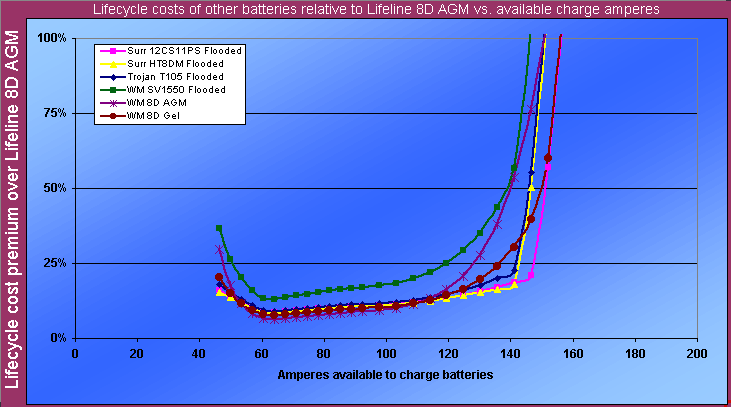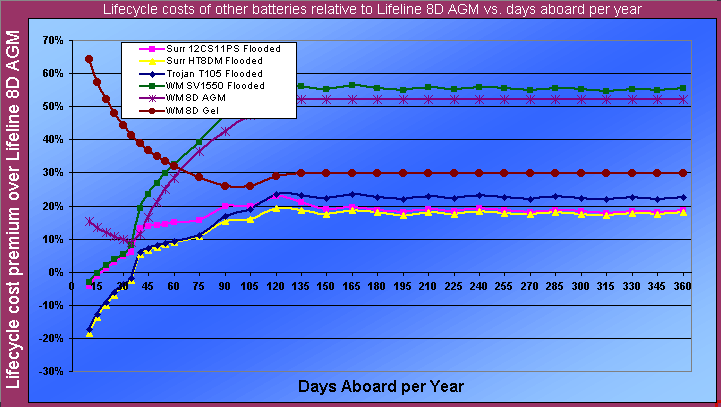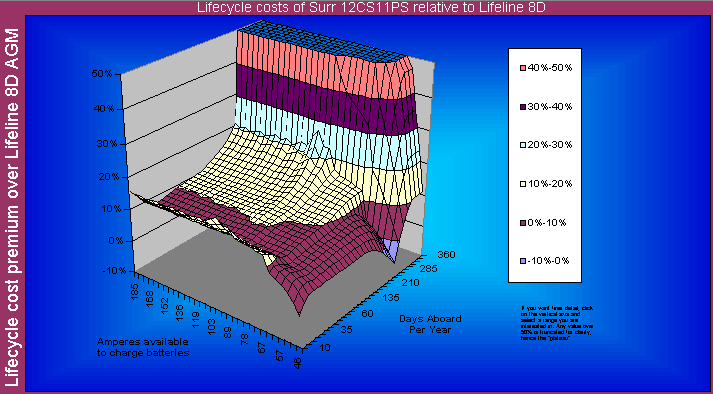Comparing Life-Cycle Costs By Battery Technology
Assuming you use your engine to recharge your batteries, how much savings does the use of AGMs translate into? I created a spreadsheet that calculated the results below. This spreadsheet accounts for just about everything: Starting with the loads on board, you arrive at a bank capacity recommendation. This battery bank can then be recharged by a variety of means: Solar, Wind/Water, Gen-Set, and engine. Each of these charge sources is properly "costed" (depreciation, maintenance, fuel costs). Using other information, such as how many days you spend on board per year (to enjoy the fruits of your labor) you can then compare system costs.
The default settings in the cost model reflect the loads on our boat, the Cat's Pyjamas. Using a 4x multiplier, we need about 400 amp-hours of capacity in the house bank. We currently have no means to charge the system save for our engine (although solar panels look pretty attractive) and after a few inputs the model goes to work. Battery parameters are based on published manufactured specifications and costs are extrapolated for a given house bank capacity. I assume year-round occupation (i.e. 1 cycle per day) and tried to keep things even by trying to standardize on group 8D batteries.
In the below comparison are Lifeline AGMs (8D) as a baseline, premium Surrette flooded cells (the 400 series model HT8DM and the 500 series model 12CS11PS - they don't make a 500 series 8D marine battery), inexpensive Trojan flooded cells (model T105 - also non 8D), and West Marine AGM and gel cells (8D). More batteries can be chosen from or added to the small database in the model.

As expected, the flooded cells do best when the available charge amperage is at 25% of the amp hour capacity of the battery bank. Gels hit the same kind of pivot point at 50% of Ah capacity. But all costs considered, Lifeline AGMs are cheaper to use. Note: I am not accounting for self-discharge losses, AGM ampere charge acceptance has been limited to 100% of battery bank amp-hour capacity.
The much lower cycle life of West Marine AGMs make them progressively more expensive as charge capacity is increased. In order to allow fair comparisons the cost model allows you to switch batteries. However, the model levels the playing field in terms of cost by using $/Ah figures. Thus, larger batteries will always have an advantage - but they may not be applicable. Ideally, you should use batteries that are close to or a multiple of the desired Ah capacity. For example, if Lifeline Group 8D's offer 255Ah and I need a 500Ah bank, that is a perfect match while the 360 Ah offered by the Trojan L16 would be too low or too high (i.e. 360 Ah vs. 720 Ah).

Well, but how do my sailing/cruising habits influence the outcome? To answer that question, you can adjust how many days per year you expect to use your boat. Given our assumptions, someone who spends more than 3 months aboard can save at least 15% by using Lifeline AGM battery storage technology.
Then you can combine the two variables and see how and when it becomes less expensive to use a Rolls CS series battery instead of an Lifeline AGM. For example, for the given loads and the size of the battery system, a small alternator / low occupancy rate results in no advantage of AGM system costs over flooded technology. However, even moderately powerful charging system and occupancy rates clearly benefit the cost effectiveness of AGM batteries.

The cost premium is expressed in percent. The brown and blue spot in the lower right hand corner is the area where AGMs are less cost effective than Surrette CS series flooded cells (by up to 11%). All other areas suggest that the AGM is more cost effective. Each color "step" denotes a ten percent change, much like a topographical map shows elevation rings. The map tops out at 50% in order to increase resolution - the peaks go higher in those regions.


